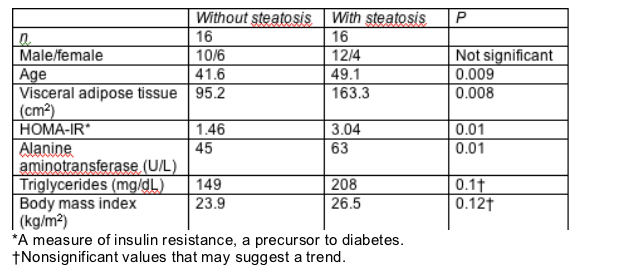 |
 |
 |
| |
Fatty Liver Found in Half of Study Group With HIV
|
| |
| |
Lipodystrophy Workshop
Exclusive report for NATAP
November 16, 2005
Half of 32 consecutively recruited HIV-infected people not being seen for liver problems had hepatic steatosis—fatty liver—in a study by Steven Grinspoon at Massachusetts General Hospital in Boston. The people with steatosis proved significantly more likely to have insulin resistance and high visceral adipose tissue, both of which correlated closely with steatosis in statistical analyses.
Grinspoon and colleagues studied 22 men and 10 women with an average age of 45.4 years, an average CD4 count of 436 cells/mm3, an average 12 years of antiretroviral experience, and normal weight (mean body mass index 25.2 kg/m2 + 0.8 standard error of mean).
No one in the group had a history of cirrhosis, none had abused alcohol in the past 3 years, and none were taking glitazones or metformin (drugs for poor glucose regulation or diabetes) or anabolic agents. But 25% had hepatitis C virus (HCV) coinfection and 28% had a history of alcohol abuse.
Sixteen people (50%) had fatty liver, defined as liver fat content above 5% measured by magnetic resonance imaging. Those with fatty liver differed from those without it in several ways:

The groups with and without steatosis did not differ by history of alcohol abuse, duration of HIV infection, HCV coinfection, or CD4 count.
Liver fat correlated positively with visceral adipose tissue (r = 0.64, P < 0.0001)
and with insulin resistance measured by HOMA (r = 0.65, P < 0.0001)
People with HIV infection may have several traits that raise the risk of fatty liver, including high visceral fat, high lipids, insulin resistance, HCV coinfection, and treatment with certain nucleosides and other drugs.
Grinspoon detailed his findings at the Lipodystrophy Workshop in Dublin.
J. Liebau, R. Andersen, S. Grinspoon, et al. Hepatic steatosis and insulin resistance in HIV infection. 7th International Workshop on Adverse Drug Reactions and Lipodystrophy in HIV. November 13-16, 2005. Dublin. Abstract 47.
|
|
| |
| |
|
 |
 |
|
|